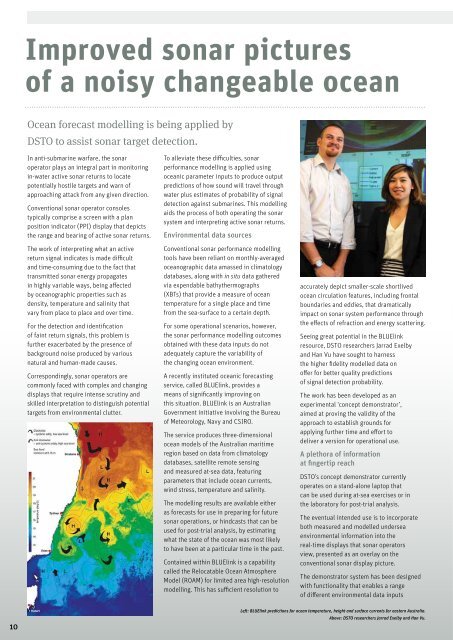DSA Volume 1 Issue 4 December 2010 - Defence Science and ...
DSA Volume 1 Issue 4 December 2010 - Defence Science and ...
DSA Volume 1 Issue 4 December 2010 - Defence Science and ...
You also want an ePaper? Increase the reach of your titles
YUMPU automatically turns print PDFs into web optimized ePapers that Google loves.
Improved sonar pictures<br />
of a noisy changeable ocean<br />
Ocean forecast modelling is being applied by<br />
DSTO to assist sonar target detection.<br />
In anti-submarine warfare, the sonar<br />
operator plays an integral part in monitoring<br />
in-water active sonar returns to locate<br />
potentially hostile targets <strong>and</strong> warn of<br />
approaching attack from any given direction.<br />
Conventional sonar operator consoles<br />
typically comprise a screen with a plan<br />
position indicator (PPI) display that depicts<br />
the range <strong>and</strong> bearing of active sonar returns.<br />
The work of interpreting what an active<br />
return signal indicates is made difficult<br />
<strong>and</strong> time-consuming due to the fact that<br />
transmitted sonar energy propagates<br />
in highly variable ways, being affected<br />
by oceanographic properties such as<br />
density, temperature <strong>and</strong> salinity that<br />
vary from place to place <strong>and</strong> over time.<br />
For the detection <strong>and</strong> identification<br />
of faint return signals, this problem is<br />
further exacerbated by the presence of<br />
background noise produced by various<br />
natural <strong>and</strong> human-made causes.<br />
Correspondingly, sonar operators are<br />
commonly faced with complex <strong>and</strong> changing<br />
displays that require intense scrutiny <strong>and</strong><br />
skilled interpretation to distinguish potential<br />
targets from environmental clutter.<br />
To alleviate these difficulties, sonar<br />
performance modelling is applied using<br />
oceanic parameter inputs to produce output<br />
predictions of how sound will travel through<br />
water plus estimates of probability of signal<br />
detection against submarines. This modelling<br />
aids the process of both operating the sonar<br />
system <strong>and</strong> interpreting active sonar returns.<br />
Environmental data sources<br />
Conventional sonar performance modelling<br />
tools have been reliant on monthly-averaged<br />
oceanographic data amassed in climatology<br />
databases, along with in situ data gathered<br />
via expendable bathythermographs<br />
(XBTs) that provide a measure of ocean<br />
temperature for a single place <strong>and</strong> time<br />
from the sea-surface to a certain depth.<br />
For some operational scenarios, however,<br />
the sonar performance modelling outcomes<br />
obtained with these data inputs do not<br />
adequately capture the variability of<br />
the changing ocean environment.<br />
A recently instituted oceanic forecasting<br />
service, called BLUElink, provides a<br />
means of significantly improving on<br />
this situation. BLUElink is an Australian<br />
Government initiative involving the Bureau<br />
of Meteorology, Navy <strong>and</strong> CSIRO.<br />
The service produces three-dimensional<br />
ocean models of the Australian maritime<br />
region based on data from climatology<br />
databases, satellite remote sensing<br />
<strong>and</strong> measured at-sea data, featuring<br />
parameters that include ocean currents,<br />
wind stress, temperature <strong>and</strong> salinity.<br />
The modelling results are available either<br />
as forecasts for use in preparing for future<br />
sonar operations, or hindcasts that can be<br />
used for post-trial analysis, by estimating<br />
what the state of the ocean was most likely<br />
to have been at a particular time in the past.<br />
Contained within BLUElink is a capability<br />
called the Relocatable Ocean Atmosphere<br />
Model (ROAM) for limited area high-resolution<br />
modelling. This has sufficient resolution to<br />
accurately depict smaller-scale shortlived<br />
ocean circulation features, including frontal<br />
boundaries <strong>and</strong> eddies, that dramatically<br />
impact on sonar system performance through<br />
the effects of refraction <strong>and</strong> energy scattering.<br />
Seeing great potential in the BLUElink<br />
resource, DSTO researchers Jarrad Exelby<br />
<strong>and</strong> Han Vu have sought to harness<br />
the higher fidelity modelled data on<br />
offer for better quality predictions<br />
of signal detection probability.<br />
The work has been developed as an<br />
experimental ‘concept demonstrator’,<br />
aimed at proving the validity of the<br />
approach to establish grounds for<br />
applying further time <strong>and</strong> effort to<br />
deliver a version for operational use.<br />
A plethora of information<br />
at fingertip reach<br />
DSTO’s concept demonstrator currently<br />
operates on a st<strong>and</strong>-alone laptop that<br />
can be used during at-sea exercises or in<br />
the laboratory for post-trial analysis.<br />
The eventual intended use is to incorporate<br />
both measured <strong>and</strong> modelled undersea<br />
environmental information into the<br />
real-time displays that sonar operators<br />
view, presented as an overlay on the<br />
conventional sonar display picture.<br />
The demonstrator system has been designed<br />
with functionality that enables a range<br />
of different environmental data inputs<br />
10<br />
Left: BLUElink predictions for ocean temperature, height <strong>and</strong> surface currents for eastern Australia.<br />
Above: DSTO researchers Jarrad Exelby <strong>and</strong> Han Vu.

















